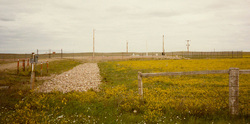 Since I was a child I have had a strange fascination with war. I would ask for picture books and check them out of the library as it was one of the few things I would read about. I had youthful plans of joining the military, but what once was a naïve patriotism has in the past 10 years become soundly checked by a growing theology and pacifism. But while I strongly disagree with war, I am still fascinated by its machinery and history. This summer I had the opportunity to explore a bit further in the beautiful land of our northern neighbor: North Dakota. I had never been much beyond Bismark. But this year brought two trips to Turtle Lake, ND and north through Minot on our journey home. One of the nuggets of knowledge that I grew up knowing was the presence of the nuclear silos across ND. It never really seemed strange to me rather a matter of fact. And yet this summer when we started passing them on the road, they were startling to me. They had been part of my mental understanding of the world but I had never had the opportunity to experience them. What seemed strange was how near they were to the road and family farms. For me, the farm I grew up on is a sacred space and I would imagine that for many in my wife’s family, the homestead is sacred as well. And yet, the missile silo just down the road for them has become a common place. To my pacifist leanings, something like that in my “backyard” would qualify a profane space. A profane space I was still attracted to and would jump at the chance to tour and explore if I had the opportunity. What are we to do with place like this that really can serve little good? Should we consider them as profane because of what is housed in the ground? or because of what it represents? or has the potential to do? If this place is profane, can it be redeemed? And then how?
0 Comments
 Last week I had the opportunity to visit one of my favorite cities: Chicago. The trip was capped off with a visit to one of my favorite places in Chicago: the Art Institute. I have become old friends with many pieces of the collection. There are some paintings that I must simply see with every visit and without those moments spent with these friends the visit is incomplete. Often my best friends are out on loan and I leave with sort of unfulfilled desire. Among my favorites is Picasso’s Old Guitarist. I remember the time I stood drawing it for my own record and the post card purchased at the gift shop to compare. I also continued my love affair with the Woman With Necklace by Modigliani. I cannot say in any conclusive way what draws me to this beautiful woman with her tilted head with a sort of arrogant beauty. Perhaps it is her red hair or her pursed lips. Regardless...she is beautiful. We were also privileged to see two wonderful photographers: Angela Strassheim and Sarah Hobbs. Hobbs series “Does This Look Like You?” explores a variety of psychological states: perfectionism (seen to the right), over-compensation, walking on eggshells and others. They were all wonderfully rich with color and composition. But it was Strassheim that made the trip to the basement worth while. The exhibit contained works from two series including “Left Behind.” The title is instantly familiar to any evangelical Christian from Tim LaHaye and Jerry Jenkins fictional series. “Photographs of Strassheim’s born again Christian family are juxtaposed with images of domestic narratives, inspired by childhood and adult life experiences. The result is an unsettling world involving complacency, control, and belief. Her images vacillate between what is immediately revealed on the surface and the unsettling nature of what is discovered upon further inspection. The combination of the visually seductive surface with the seemingly banal subject matter elicits an involved interpretation of the many layers within the images. These narratives and portraits retain an element of mystery that asks the viewer to question the acts that lead up to or follow each scenario.Drawing from her experience as a forensic photographer, Angela Strassheim has developed a style remarkably original in its obsessively careful compositions and lighting, in its uncanny sharpness. Apparently simple scenes acquire a suspended atmosphere, in which religion, suburban life and personal memories converge.Left Behind refers not only to the “unsaved” spoken about by her born again Christian family but also the memory and evidence people create that outlives them. It is both, being left behind and leaving, either of our own free will or having life taken away.” (From the press release regarding the show at Marvelli Gallery in NYC.) I am not sure where Strassheim comes from in terms of her own faith but the imagery is fascinating. Her carefully arranged compositions and flawless lighting seem to suggest a moral perfection and yet there is a tension between the presentation of and yet subtle sexual posturing in many of the figures. This image was particularly arresting. The boy on the left is asleep and the one on the right is afraid and hiding under the bed. And the girl, alive with imagination is silhouetted in a (divine?) light. Do the boys represent a sort of critique of Christians themselves as aloof or passively asleep and the other afraid of the world? Are the collection of animals streaming from the doorway have some symbolic connection to the ark? Do the wings on the young girl make her the ideal between the poles of indifference and fear? |
Ryan StanderArchives
January 2018
Categories
All
|

 RSS Feed
RSS Feed
